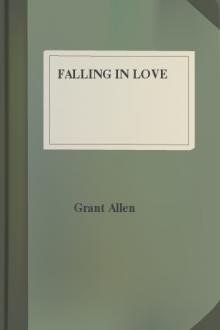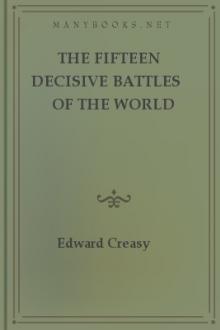Falling in Love by Grant Allen (different e readers .txt) 📕

- Author: Grant Allen
- Performer: -
Book online «Falling in Love by Grant Allen (different e readers .txt) 📕». Author Grant Allen
A few years ago, too, Dr. Tripe was watching a very severe thunderstorm, when he saw a fire-ball come quietly gliding up to him, apparently rising from the earth rather than falling towards it. Instead of running away, like a practical man, the intrepid doctor held his ground quietly and observed the fiery monster with scientific nonchalance. After continuing its course for some time in a peaceful and regular fashion, however, without attempting to assault him, it finally darted off at a tangent in another direction, and turned apparently into forked lightning. A fire-ball, noticed among the Glendowan Mountains in Donegal, behaved even more eccentrically, as might be expected from its Irish antecedents. It first skirted the earth in a leisurely way for several hundred yards like a cannon-ball; then it struck the ground, ricochetted, and once more bounded along for another short spell; after which it disappeared in the boggy soil, as if it were completely finished and done for. But in another moment it rose again, nothing daunted, with Celtic irrepressibility, several yards away, pursued its ghostly course across a running stream (which shows, at least, there could have been no witchcraft in it), and finally ran to earth for good in the opposite bank, leaving a round hole in the sloping peat at the spot where it buried itself. Where it first struck, it cut up the peat as if with a knife, and made a broad deep trench which remained afterwards as a witness of its eccentric conduct. If the person who observed it had been of a superstitious turn of mind we should have had here one of the finest and most terrifying ghost stories on the entire record, which would have made an exceptionally splendid show in the 'Transactions of the Society for Psychical Research.' Unfortunately, however, he was only a man of science, ungifted with the precious dower of poetical imagination; so he stupidly called it a remarkable fire-ball, measured the ground carefully like a common engineer, and sent an account of the phenomenon to that far more prosaic periodical, the 'Quarterly Journal of the Meteorological Society.' Another splendid apparition thrown away recklessly, for ever!
There is a curious form of electrical discharge, somewhat similar to the fire-ball but on a smaller scale, which may be regarded as the exact opposite of the thunderbolt, inasmuch as it is always quite harmless. This is St. Elmo's fire, a brush of lambent light, which plays around the masts of ships and the tops of trees, when clouds are low and tension great. It is, in fact, the equivalent in nature of the brush discharge from an electric machine. The Greeks and Romans looked upon this lambent display as a sign of the presence of Castor and Pollux, 'fratres Helenæ, lucida sidera,' and held that its appearance was an omen of safety, as everybody who has read the 'Lays of Ancient Rome' must surely remember. The modern name, St. Elmo's fire, is itself a curiously twisted and perversely Christianised reminiscence of the great twin brethren; for St. Elmo is merely a corruption of Helena, made masculine and canonised by the grateful sailors. It was as Helen's brothers that they best knew the Dioscuri in the good old days of the upper empire; and when the new religion forbade them any longer to worship those vain heathen deities, they managed to hand over the flames at the masthead to an imaginary St. Elmo, whose protection stood them in just as good stead as that of the original alternate immortals.
Finally, the effects of lightning itself are sometimes such as to produce upon the mind of an impartial but unscientific beholder the firm idea that a bodily thunderbolt must necessarily have descended from heaven. In sand or rock, where lightning has struck, it often forms long hollow tubes, known to the calmly discriminating geological intelligence as fulgurites, and looking for all the world like gigantic drills such as quarrymen make for putting in a blast. They are produced, of course, by the melting of the rock under the terrific heat of the electric spark; and they grow narrower and narrower as they descend till they finally disappear. But to a casual observer, they irresistibly suggest the notion that a material weapon has struck the ground, and buried itself at the bottom of the hole. The summit of Little Ararat, that weather-beaten and many-fabled peak (where an enterprising journalist not long ago discovered the remains of Noah's Ark), has been riddled through and through by frequent lightnings, till the rock is now a mere honeycombed mass of drills and tubes, like an old target at the end of a long day's constant rifle practice. Pieces of the red trachyte from the summit, a foot long, have been brought to Europe, perforated all over with these natural bullet marks, each of them lined with black glass, due to the fusion of the rock by the passage of the spark. Specimens of such thunder-drilled rock may be seen in most geological museums. On some which Humboldt collected from a peak in Mexico, the fused slag from the wall of the tube has overflowed on to the surrounding surface, thus conclusively proving (if proof were necessary) that the holes are due to melting heat alone, and not to the passage of any solid thunderbolt.
But it was the introduction and general employment of lightning-rods that dealt a final deathblow to the thunderbolt theory. A lightning-conductor consists essentially of a long piece of metal, pointed at the end whose business it is, not so much (as most people imagine) to carry off the flash of lightning harmlessly, should it happen to strike the house to which the conductor is attached, but rather to prevent the occurrence of a flash at all, by gradually and gently drawing off the electricity as fast as it gathers before it has had time to collect in sufficient force for a destructive discharge. It resembles in effect an overflow pipe which drains off the surplus water of a pond as soon as it runs in, in such a manner as to prevent the possibility of an inundation, which might occur if the water were allowed to collect in force behind a dam or embankment. It is a flood-gate, not a moat: it carries away the electricity of the air quietly to the ground, without allowing it to gather in sufficient amount to produce a flash of lightning. It might thus be better called a lightning-preventer than a lightning-conductor: it conducts electricity, but it prevents lightning. At first, all lightning-rods used to be made with knobs on the top, and then the electricity used to collect at the surface until the electric force was sufficient to cause a spark. In those happy days, you had the pleasure of seeing that the lightning was actually being drawn off from your neighbourhood piecemeal. Knobs, it was held, must be the best things, because you could incontestably see the sparks striking them with your own eyes. But as time went on, electricians discovered that if you fixed a fine metal point to the conductor of an electric machine it was impossible to get up any appreciable charge because the electricity kept always leaking out by means of the point. Then it was seen that if you made your lightning-rods pointed at the end, you would be able in the same way to dissipate your electricity before it ever had time to come to a head in the shape of lightning. From that moment the thunderbolt was safely dead and buried. It was urged, indeed, that the attempt thus to rob Heaven of its thunders was wicked and impious; but the common-sense of mankind refused to believe that absolute omnipotence could be sensibly defied by twenty yards of cylindrical iron tubing. Thenceforth the thunderbolt ceased to exist, save in poetry, country houses, and the most rural circles; even the electric fluid was generally relegated to the provincial press, where it still keeps company harmoniously with caloric, the devouring element, nature's abhorrence of a vacuum, and many other like philosophical fossils: while lightning itself, shorn of its former glories, could no longer wage impious war against cathedral towers, but was compelled to restrict itself to blasting a solitary rider now and again in the open fields, or drilling more holes in the already crumbling summit of Mount Ararat. Yet it will be a thousand years more, in all probability, before the last thunderbolt ceases to be shown as a curiosity here and there to marvelling visitors, and takes its proper place in some village museum as a belemnite, a meteoric stone, or a polished axe-head of our neolithic ancestors. Even then, no doubt, the original bolt will still survive as a recognised property in the stock-in-trade of every well-equipped poet.
HONEY-DEWPlace, the garden. Time, summer. Dramatis personæ, a couple of small brown garden-ants, and a lazy clustering colony of wee green 'plant-lice,' or 'blight,' or aphides. The exact scene is usually on the young and succulent branches of a luxuriant rose-bush, into whose soft shoots the aphides have deeply buried their long trunk-like snouts, in search of the sap off which they live so contentedly through their brief lifetime. To them, enter the two small brown ants, their lawful possessors; for ants, too, though absolutely unrecognised by English law ('de minimis non curat lex,' says the legal aphorism), are nevertheless in their own commonwealth duly seised of many and various goods and chattels; and these same aphides, as everybody has heard, stand to them in pretty much the same position as cows stand to human herdsmen. Throw in for sole spectator a loitering naturalist, and you get the entire mise-en-scène of a quaint little drama that works itself out a dozen times among the wilted rose-trees beneath the latticed cottage windows every summer morning.
It is a delightful sight to watch the two little lilliputian proprietors approaching and milking these their wee green motionless cattle. First of all, the ants quickly scent their way with protruded antennæ (for they are as good as blind, poor things!) up the prickly stem of the rose-bush, guided, no doubt, by the faint perfume exhaled from the nectar above them. Smelling their road cautiously to the ends of the branches, they soon reach their own particular aphides, whose bodies they proceed gently to stroke with their outstretched feelers, and then stand by quietly for a moment in happy anticipation of the coming dinner. Presently, the obedient aphis, conscious of its lawful master's friendly presence, begins slowly to emit from two long horn-like tubes near the centre of its back a couple of limpid drops of a sticky pale yellow fluid. Honey-dew our English rustics still call it, because, when the aphides are not milked often enough by ants, they discharge it awkwardly of their own accord, and then it falls as a sweet clammy dew upon the grass beneath them. The ant, approaching the two tubes with cautious tenderness, removes the sweet drops without injuring in any way his little protégé, and then passes on to the next in order of his tiny cattle, leaving the aphis apparently as much relieved by the process as a cow with a full hanging udder is relieved by the timely attention of the human milkmaid.
Evidently, this





Comments (0)